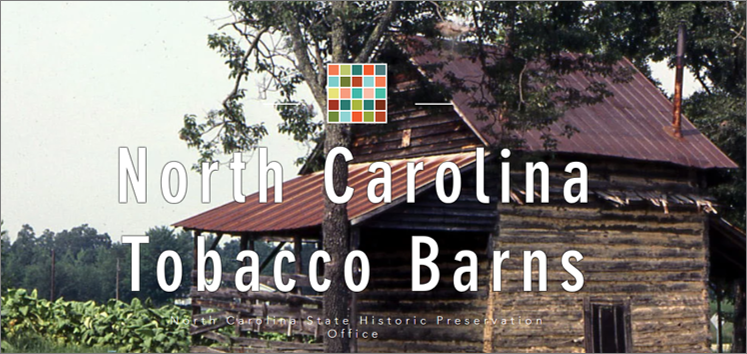Celebrate Tobacco Barns
"North Carolina without tobacco barns would be like Holland without windmills." - David L.S. Brook, past Director, Division of Historical Resources
Be sure to visit our engaging and interactive story map, North Carolina Tobacco Barns, which shares the content of this page in a fresh and modern way!
Please Note: With extremely rare exceptions (see "Preserving Tobacco Barns" below) there are no grants or other financial assistance for private restorations of tobacco barns. Staff of the Restoration Services Branch of the State Historic Preservation Office provides consultations on a time-available basis to owners of all types of historic properties and may be able to recommend conservation treatments and make referrals to qualified contractors. Ask the restoration specialist who serves your area of the state.
Tobacco has been an essential part of the state's economic and social history for three centuries. The leaf supported thousands of families for many generations and helped create cities, support universities, and build hospitals across the state. The traditional tobacco barn has long been symbolic of the crop's significance in Tar Heel life.
The last quarter of the 20th century brought enormous changes in North Carolina's tobacco industry, including the way that farmers cure their tobacco. Modern bulk curing systems have made every traditional flue-cure tobacco barn in the state obsolete, and the abandoned barns are rapidly disappearing.
South Georgia Tobacco Patch. A detailed reminiscence by Jesse Bookhardt of Georgia of growing up on a tobacco farm in the mid-20th century, with all of the stages of planting, raising, curing, and marketing tobacco, written from the perspective of someone who had a hands-on role in every part of the work. Some specifics of the process and some of the terminology differ slightly from the flue-cure tobacco traditions of North Carolina, but thousands of Tar Heels, and many in other flue-cure tobacco regions of the country, will find his story familiar. Jesse has generously permitted us to post his account on this web site.
One, two, three, four......Say, how many tobacco barns are there, anyway?
Not as many as there were yesterday. This long train of Wilson County barns
and many others like it have vanished.
Where the Barns Are: The distribution of tobacco barns across North Carolina, and some observations about how they differ from region to region. This barn in Columbus County looks ready for takeoff.
Preserving Tobacco Barns. Unlike old houses and commercial buildings, tobacco barns don't offer many opportunities for adaptation for other uses. Here are a few examples of how some are being preserved.
Tobacco Museums you can visit. There are two museums devoted principally to the history of tobacco culture, and others that have a tobacco component.
A Day on the Carter Farm in Rockingham County, August 1985. Go back and join the Carter family and their neighbors in a day of traditional priming and curing. The old ways of working in tobacco have since vanished, on the Carter Farm and all across the state.
Tobacco Barn Photographs by Nancy O. Albert

